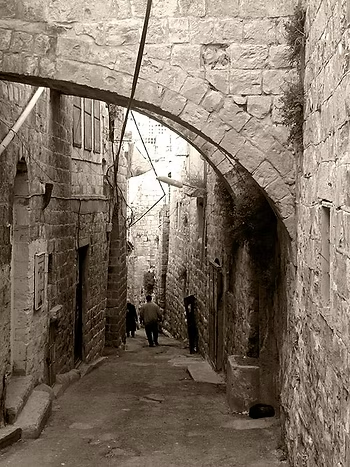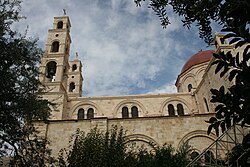Nablus
- Mike O'Brien

- Aug 15, 2025
- 3 min read
Updated: Aug 16, 2025
(Over the next few weeks we will look at each of the different Christian communities that exist throughout the Holy Land. To appreciate the unique gifts they bring to the region and the unique challenges they face).
The Christian Community of Nablus, West Bank

Nablus, an ancient city in the Central Highlands of the West Bank about 40 miles north of Jerusalem, is one of the largest Palestinian cities and a vibrant hub of commerce, education, and culture. Home to An-Najah National University and the Palestinian Stock Exchange, the city is also famous for its historic Old City markets, sweet kanafeh, and centuries-old olive-oil soap production.
From left to right: Jesus with the Samaritan woman, Jacob's well and the Church of St. Photini
Its Arabic name comes from the Roman Neapolis, founded near the biblical city of Shechem, which lies between Mount Ebal and Mount Gerizim - two peaks central to covenant rituals described in Deuteronomy and Joshua.
Shechem occupies a special place in the biblical narrative. According to Genesis 12, Abram built an altar here when God confirmed His covenant. Jacob purchased land and dug a well, now inside the Greek Orthodox Church of St. Photini, which tradition also associates with Jesus’ meeting with the Samaritan woman (John 4).
Nearby is Joseph’s Tomb, long venerated as the burial site of Jacob’s son. Joshua gathered the Israelites here to renew their commitment to the God of Abraham (Joshua 24), and after Solomon’s death, Shechem was the first capital of the northern Kingdom of Israel.
Under Roman, Byzantine, and later Ottoman rule, Nablus developed into a thriving urban center. Modelled in part after Damascus, it retains narrow alleyways, public fountains, ornate balconies, and historic mosques.

The Old City remains the commercial heart, with bustling souks selling spices, sweets, textiles, and the city’s signature castile-type soap, made from virgin olive oil, water, and qilw since the 10th century.
Today, the district’s population is around 250,000, with Christians numbering roughly 650. This small but historic community—present since the earliest centuries of the Church—is composed mainly of Greek Orthodox, Latin (Roman Catholic), Anglican, and Melkite believers. Despite their small numbers, they maintain a strong ecumenical spirit, agreeing to celebrate Christmas together on December 25 (Western calendar) and Easter according to the Eastern Orthodox date.
The Latin Church of St. Justinus in Rafidia, built in 1887, is served by the Rosary Sisters, who also founded St. Joseph School in 1904. The school, now run by the Latin Patriarchate, welcomes Christians, Muslims, and Samaritans from kindergarten through 12th grade. Though only 10% of students are Christian, the school emphasizes both academic excellence and Christian ethos, offering additional courses in French and music.
The Anglican Diocese of Jerusalem maintains St. Philip’s Church in Nablus and the Good Shepherd Church in Rafidia. They run youth groups, women’s ministries, Sunday schools, and the Christian National Kindergarten. The Diocese also operates St. Luke’s Hospital, founded in 1900, the only charitable hospital in the northern West Bank. Known for neurosurgery, obstetrics, and neonatal care, it treats thousands of patients annually, many of whom receive financial support thanks to donations from organizations like Friends of the Holy Land. This support not only covers treatment for poor families but also sustains jobs for Christian medical staff in a region with limited employment opportunities.

Adding to Nablus’s unique religious mosaic is the Samaritan community, which resides on Mount Gerizim. Numbering only about 800 people, they trace their ancestry to the biblical tribes of Israel and believe the mountain is the true holy site chosen by God. The Samaritans’ traditions and rituals connect them to an unbroken heritage spanning over two millennia.
Life for Nablus’s Christians is marked by resilience. They face challenges such as political instability, economic constraints, and emigration, particularly among young people seeking opportunities abroad. Yet their deep-rooted presence, maintained through churches, schools, and charitable institutions, reflects both their determination and their role as custodians of a living link between the Bible’s sacred geography and modern Palestinian society.
From the biblical wells and tombs of Shechem to the modern classrooms and hospital wards of Nablus, the city’s Christian community continues to embody faith, service, and cultural heritage in one of the most storied landscapes in the Holy Land.

)%20(2)_edited.jpg)








Comments